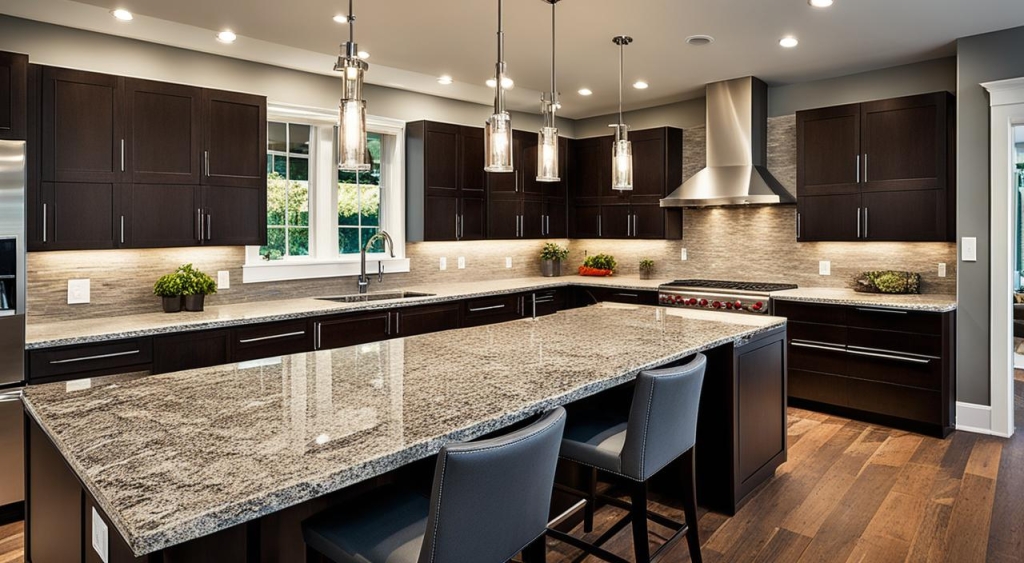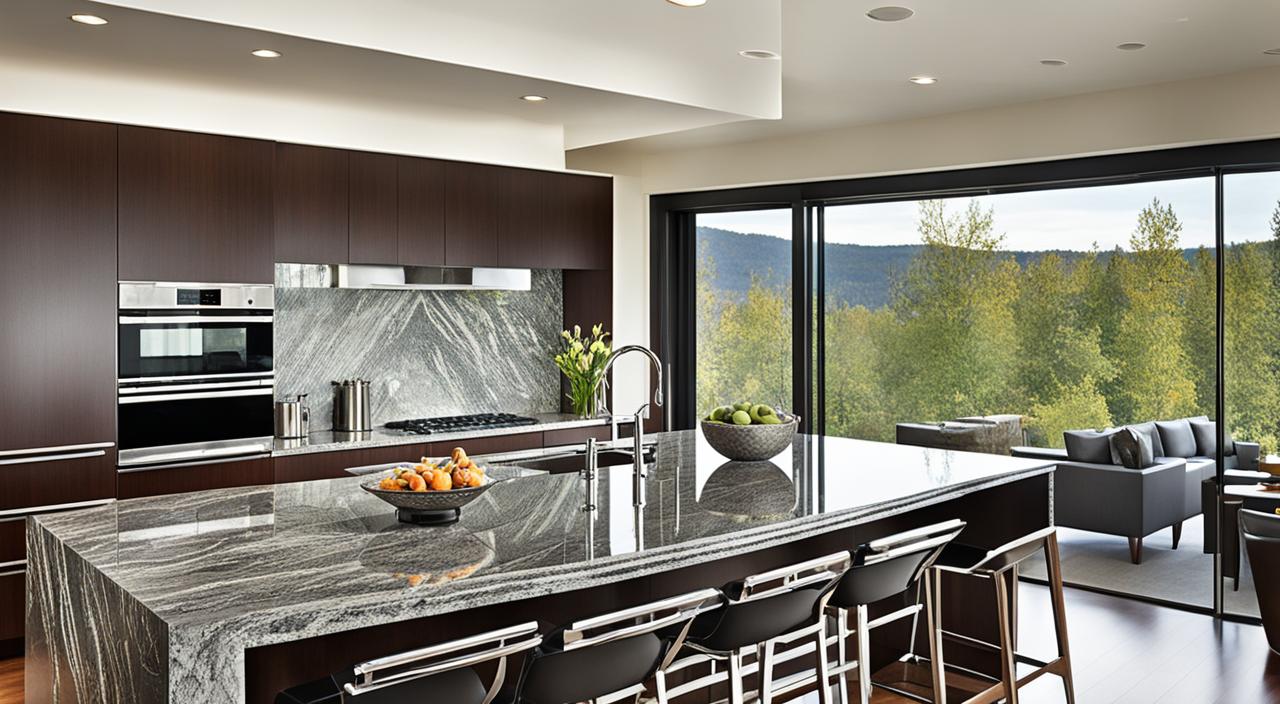Table of Contents
- Benefits of Granite Countertops
- Luxury & Excellence with Granite Countertops
- Granite’s Functional Elegance and Durability: A Culinary Paradise
- Adding Value and an Investment in Sophisticated Stone Craftsmanship
- Exploring Luxurious Granite Options with Granite Direct
- Exquisite Granite Countertop Solutions: Customization at Its Finest
- Conclusion
- FAQ
- What are the benefits of granite countertops?
- Why are granite countertops considered luxurious?
- Are granite countertops suitable for kitchens?
- How can stone craftsmanship add value to my home?
- What customization options does Granite Direct offer?
- Can I customize my granite countertops?
- How do granite countertops add value to my home?
Benefits of Granite Countertops
Imagine entering a space where sophistication is everywhere. As a discerning homeowner, consider how high-end granite countertops can elevate your kitchen. They show off your taste for premium finishes. Granite tops have been a symbol of luxury for ages. They mix durability with beauty. Granite countertops are a luxurious addition to any home because they are incredibly durable and low-maintenance. Granite is known for upscale kitchen countertops because it brings beauty and sophistication.

Touching elegant natural stone surfaces means more than following a trend. You’re investing in a legacy treasured by many generations. Quality stone countertops offer lasting beauty. They reflect sophistication that matches your lifestyle.
Key Takeaways
- The enduring appeal of luxury & excellence with granite countertops in the narrative of high-end homes.
- The significance of premium granite finishes in crafting an affluent ambiance.
- Inherent qualities of granite that make it suitable for sophisticated stone craftsmanship and upscale countertop installation.
- The variety of luxurious granite options encompasses various colors and patterns.
- How exquisite granite countertop solutions add value and elegance to your abode.
Luxury & Excellence with Granite Countertops
Granite countertops represent the peak of luxury and excellence in elegant home decor. They combine stunning looks with top-notch quality. Each piece is a blend of beauty and functionality, making your spaces look splendid. These countertops last a long time, serving not just as a tool for daily tasks but as a luxurious highlight.
Choosing granite means you’re boosting your home’s value. Every slab is made tough, ready to face years of use while staying trendy. They come in various designs and colors, making matching any room’s style easy. Granite makes everything more sophisticated.
Granite countertops are a confluence of nature’s strength and human craftsmanship, designed to deliver a superior level of home luxury.
To pick the suitable granite for you, it’s vital to know your options. There’s a table below with popular granite choices, showing what makes each unique and how they fit different styles:
| Granite Type | Color Variance | Suitable for Decor Style |
|---|---|---|
| Absolute Black | Minimalist, Sleek | Modern, Contemporary |
| Bianco Romano | Soft White with Gray Veins | Classic, Farmhouse |
| Blue Pearl | Vibrant Blue with Silver Flecks | Luxurious, Statement |
| Tan Brown | Rich Brown with Contrasting Flecks | Warm, Inviting |
| Ubatuba | Dark Green with Gold Specks | Traditional, Earthy |
Granite isn’t just about colors; its texture can suit any taste. It can be polished, honed, or brushed to match your style. Choosing granite is a decision for the ages, offering beauty and function.
- Durable and long-lasting: Resistant to chips, scratches, and heat damage.
- Elegant home decor: Transforms spaces with its natural elegance.
- Adding value to your home: Known to boost property resale values.
Thinking about adding granite’s timeless elegance to your home? It’s sure to show your taste for high-quality craftsmanship and lasting style. Investing in kitchen or bathroom granite countertops brings beauty to your home for many years to come.
Think of a sleek, modern kitchen with floor-to-ceiling windows and plenty of natural light. The countertop is the centerpiece, made of luxurious granite with rich veins and intricate patterns. It’s so polished you can see your reflection in it. The surface is cool to the touch but inviting, begging you to prepare a gourmet meal or host a sophisticated dinner party. The color palette is neutral, allowing the granite to steal the show, but subtle hints of gold and silver are in the veins, adding to its elegance. The edges are impeccably crafted, smooth, and sharp with no imperfections. Imagine the feeling of running your hand over it – it’s satisfyingly smooth and cool, like a fancy hotel lobby. This countertop exudes luxury and excellence at every angle.

Granite’s Functional Elegance and Durability: A Culinary Paradise
Starting a kitchen makeover? It’s tough to ignore the charm of a durable countertop surface. Granite shines here, known for its functional elegance. It’s praised for its heat-resistant abilities, making it a favorite among cooks. They love it because it can handle hot pans straight from the stove,
Sparkling granite countertops in a modern, minimalist kitchen, with a pan sizzling away on the stove while the chef chops vegetables on the smooth surface.
For those valuing looks and practicality, granite’s scratch-resistant surface stands out. It resists daily wear and tear from cooking. A study in April 2012 favored granite over marble or ceramic, hailing its lasting durability and style. This blend of function and beauty creates a culinary paradise. The kitchen becomes a haven for food lovers and social gatherings.
Granite’s natural beauty isn’t just in handling kitchen tasks. It’s also incredibly easy to clean and maintain. Now more affordable, granite invites more homes to enjoy its luxury. A 2012 survey confirmed it’s unbeaten in combining practicality and elegance in kitchens.
But granite is one of many top choices. Onyx Marble, captivating with its ability to let light through, offers a unique charm. With its vast experience, Granite Direct provides a stunning Onyx Marble range. Each piece is unique, meeting diverse tastes.
In May 2012, 3-D marble tiles brought new life to interiors. It was a time when Neolith made bathroom design affordable. Granite Direct’s onyx marble selection matches this innovation. Their prices reflect the rare beauty and customization options, fitting various budgets.
Choosing between granite and Onyx Marble isn’t just about picking a surface. It’s about shaping an experience. These materials offer kitchens beyond just utility. They’re spaces of functional elegance, where meals are moments of personal creativity and joy.
Adding Value and an Investment in Sophisticated Stone Craftsmanship
Are you thinking about upgrading your home? Skilled stone craftsmanship makes a big difference. Choosing sophisticated stone finishes means more than just a new look. It’s an investment in your home’s future. Materials like marble, granite, and quartz are durable and resist wear and tear.
Intricate detailing shows the marks of true masters. Their work with customized stone creations brings unique character and value. Quality stone countertops in your bathroom are smart choices. They’re easy to clean and keep your space looking great with little effort. The right choices in stone can make your home more valuable and add peace of mind. They become a luxurious highlight that attracts potential buyers.
- Longevity of Materials
- Partnerships with Top Brands
- Personalized Customer Service
Working with top brands like Silestone, Cambria, and Caesarstone ensures quality and stands the test of time. These partnerships show a commitment to the best. You can trust your stone features to stay beautiful and functional for years.
We aim to go beyond what homeowners expect. Customer happiness is critical, from the first design meeting to the final setup. Let the desire to add value drive your next home project. Choose customized stone creations for elegance. See how refined touches can transform your living space.
Exploring Luxurious Granite Options with Granite Direct
Granite Direct offers a wide selection of granite to improve your home. Our granite combines luxury with function. Granite countertops are durable, easy to care for and add beauty. They can also increase your home’s resale value because they are linked with luxury.
Granite is great for busy kitchens because it is resistant to scratches, heat, and stains. It’s also easy to maintain: wipe with a damp cloth or mild soap. Our granite customization service lets you choose the perfect color and pattern, making your countertops unique.
About 90% of homeowners upgrading their homes choose new countertops, focusing on durability, versatility, and ease of cleaning. Granite stands out for its luxury and practicality. It offers sophistication and elegance for modern homes.
Choosing Granite Direct means getting a standout piece for your home. Our luxurious granite options add natural beauty or a bold, modern look. Let our custom granite transform your space today.
Exquisite Granite Countertop Solutions: Customization at Its Finest
Exploring home renovation? Customized granite countertops are essential to aesthetics and taste. They let you create a space that reflects your style. These specialists craft personalized granite that fits your unique style. They transform granite into an essential piece of your home’s charm.
The possibilities with granite are endless. Imagine your kitchen with countertops that show off your style. You can choose from elegant shades to vibrant patterns. There’s a finish for everyone – glossy, matte, or smooth. Each one makes your kitchen a special place.
Experts pick the perfect granite that matches your taste and home. Choosing the right materials for even small kitchens. Our smart designs maximize every inch of space with style.
Granite Direct offers customized luxury. With luxury vinyl flooring, Granite Direct brings durability and elegance to spaces-blending quality, sustainability, and luxury beautifully.
- Wide Selection of Materials – Granite, Quartz, Marble, and more
- Customization Tailored to Your Aesthetic Desires
- Expert Artisans Crafting Unique Visual Narratives
- Efficient Use of Every Inch of Space, Especially in Small Kitchens
Choose granite surfaces to add warmth and luxury to your home. Let the mix of nature and craftsmanship create a luxury space for you.
Conclusion
Thinking about adding timeless luxury to your home? Granite countertops are a wise choice. With years of experience, Granite Direct offers high-quality, stylish surfaces. They use the latest technology and strict quality checks. Plus, they truly care about their customers, providing personalized service.
Granite is not only beautiful but also tough. You can put hot pots and pans directly on it without damage. If you’re considering other materials, quartz is over 90% real stone and scratch-resistant. Soapstone is non-porous, meaning it’s easy to clean and doesn’t need sealing. You have many options to match your style and needs.
Choosing granite means making your kitchen both beautiful and durable. To bring granite’s luxury into your home and uplift your space with expert stone craftsmanship, contact Granite Direct at 303-282-8317. They’ll help transform your living area with stunning granite solutions.
FAQ
What are the benefits of granite countertops?
Granite countertops bring beauty and luxury to any room. They last a long time and resist heat, scratches, and stains. They also increase your home’s value.
Why are granite countertops considered luxurious?
Granite countertops stand out for their natural beauty and unique patterns. They add a touch of elegance and luxury to spaces.
Are granite countertops suitable for kitchens?
Yes, granite countertops are great for kitchens. They can handle the heat and are tough against scratches. Plus, they’re simple to clean.
How can stone craftsmanship add value to my home?
Expert stonework makes your home more valuable. It offers unique, detailed stone finishes that boost your space’s look and give it a custom feel.
What customization options does Granite Direct offer?
Granite Direct lets you choose from many luxurious granite styles. You can pick the best color, pattern, and texture for your decor. They offer tailor-made granite for a special touch.
Can I customize my granite countertops?
Yes, you can design your granite countertops. You can make countertops with custom finishes and designs that show your style.
How do granite countertops add value to my home?
Granite countertops boost your home’s look and durability. They are a smart investment, raising your property value.

